SI Fantasy analyst Shawn Childs provides his read on this year's crop of NFL Draft talent at the wide receiver position
Top Prospects by Position
Quarterbacks | Running Backs | Wide Receivers | Tight Ends
1. Ja’Marr Chase, LSU
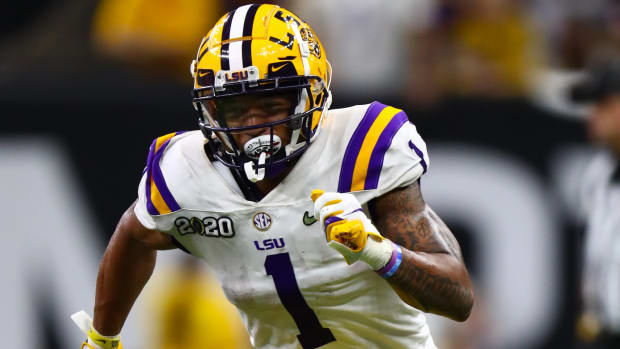
After a dominating sophomore season (84/1,780/20) at LSU with Joe Burrow behind center, Chase elected to sit out 2020 due to Covid concerns. His best success came in four explosive games (10/229/4, 8/227/3, 7/197/7, and 9/221/2) while also gaining over 100 yards in five other contests (8/147, 7/127/2, 8/123, 6/140/1, and 6/144/2).
He comes to the NFL with some concern with his route running and ability to beat the press vs. top physical cornerbacks. I don’t view either opinion or thought as an issue. Chase will work the short areas of the field to be a chain mover on quick slants, comebacks, and crossing patterns. LSU used him on bubble screens and deep end cuts showing his versatility to make plays in the passing game. He’ll need to fine-tune some areas of his game at the next level. Chase works hard while owning the movements to shine all over the field.
Chase thrived on winning in the deep passing thanks to great hands and his explosiveness over the long field in college. He’ll command double coverage and win many jump balls. His foundation skill set is elite while having a difference-maker ceiling.
The NFL has lacked the next wave of electric 100-catch wide receivers to replace Andre Johnson, Larry Fitzgerald, and Brandon Marshall. Chase will stand tall in the NFL while expecting him to have a Hall of Fame career. He should be the first wide receiver off the board this season, and I hope the Bengals swoop in and add him with their young developing offense with the fifth pick overall.
2. Devonta Smith, Alabama
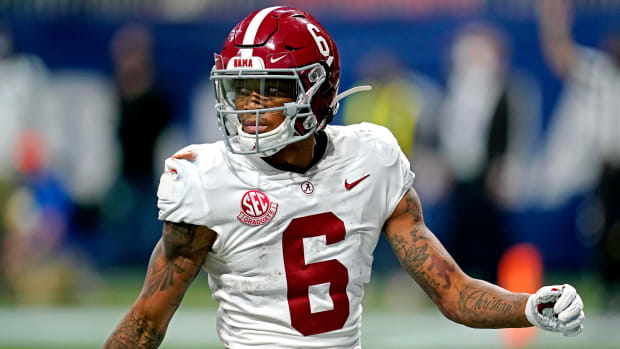
In each season at Alabama, Smith improved each of his stats. His window for playing time and chances were limited early in his college career due to the Crimson Tide having exceptional depth and talent at wide receiver (Calvin Ridley, Jerry Jeudy, Henry Ruggs, and Jaylen Waddle). After showing growth in 2019 (68/1,256/14), Smith won the Heisman Trophy last season after catching 117 passes for 1,856 yards and 23 touchdowns. He capped off the year with three explosive showings (15/184/2, 7/130/3, and 12/215/3), with the latter coming in the national championship game.
Smith can run a sub 4.40 forty-yard dash, but he lacks size (6’0” and 175 lbs.), which may deter some teams from adding him as a franchise first-round pick. He makes up for this shortfall with great route running, extreme quickness, and open field ability.
Last year Alabama used him on many plays where he started behind the line of scrimmage to take advantage of his speed and quickness. His movements and frame had a DeSean Jackson feel, but Smith will get many more chances over the short-areas of the field. I expect him to own an edge out of the slot, and he will get off the line better than expected against press coverage for his size and strength.
3. Jaylen Waddle, Alabama
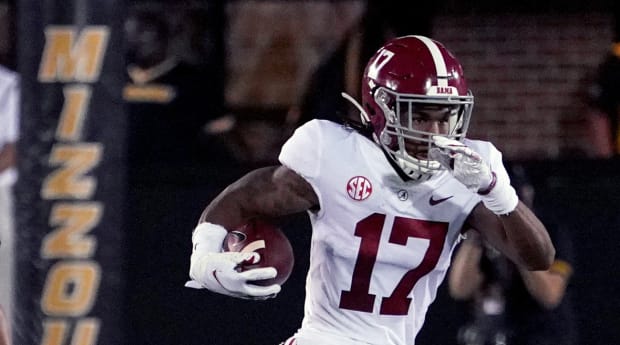
Over three seasons at Alabama, Waddle caught 106 passes for 1,999 yards and 17 touchdowns. His best year came in his freshman year (45/848/7). In 2020, he missed six games with an ankle injury. Waddle started last season with four dynamic games (8/134/2, 5/142/1, 6/120, and 6/161/1), which was his first opportunity to shine as a top-two receiver for the Crimson Tide. He returned 20 punts for 487 yards and a touchdown in his sophomore year, plus five kickoffs for 175 yards and a score.
His play in college gives him an explosive depth threat feel, but his quickness, vision, and route running project to be a more complete player. Waddle is excellent in the open field with the ball in his hands while playing bigger than his size (5’10” and 180 lbs.). His experience against press coverage is limited, and many of his catches came in space.
I sense traits of Antonio Brown with a lot less experience and opportunity in college. Waddle has strength in his lower body with the skill set to create a catching window all over the field. I would love to see him land in Green Bay to play on the opposite side of Davante Adams.
4. Terrace Marshall, LSU
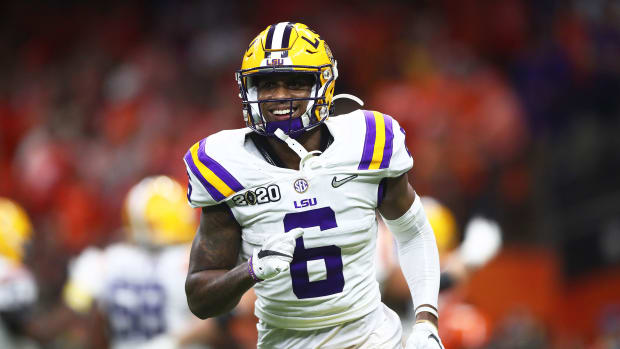
In 2019, Marshall caught a piece of the Joe Burrow ride to the national championship, leading to 46 catches for 671 yards and 13 touchdowns. He flashed over the first seven games last year (48/731/10) before opting out. His best output came in the third game (11/235/3) of the season against Missouri.
He projects to be a vertical threat early in his career while doing damage on comeback throws. Marshall offers size (6’2” and 205 lbs.) and speed (4.38 forty at his pro day). His release looks questionable and lacks tempo. To reach a high level, he needs to add more fight to his game off the snap and at the top of his routes.
Overall, Marshall has a professional feel with the talent to play well as WR2 in a top offense. His ceiling falls on his motivation to work hard on his route running.
5. Elijah Moore, Ole Miss
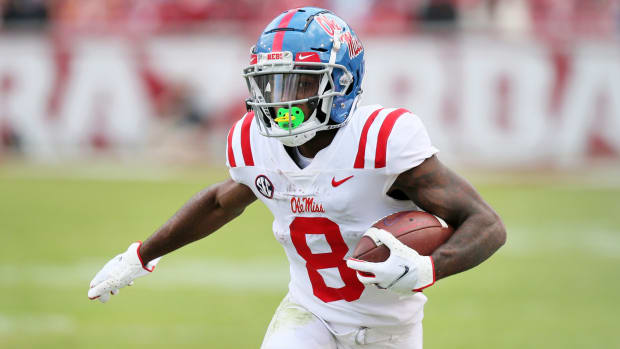
Moore is another undersized wide receiver (5’9” and 185 lbs.) in the 2021 draft class. He finished last year with eight catches for 1,193 yards and eight touchdowns, which is even more impressive when adding in only eight games played. Moore had seven games with 10 catches or more. His season started with an excellent outing (10/227) and ended with three straight impact games (14/238/3, 13/225/2, and 12/139).
He projects as a slot receiver with the ability to test a defense in the deep passing game. Moore will be a zone buster while possibly struggling against physical corners in tight coverage. His release looks favorable with the hands to win in close quarters.
Moore continues to improve while offering sneaky upside. His reported 40-yard time (sub 4.40) put him in the game with the top receivers in this year’s draft. An NFL team looking for an inside receiver will be thrilled with what he brings to the table. Saints had success with Brandin Cooks, which may be the best place for Moore to hit the ground running.
6. Rashod Bateman, Minnesota
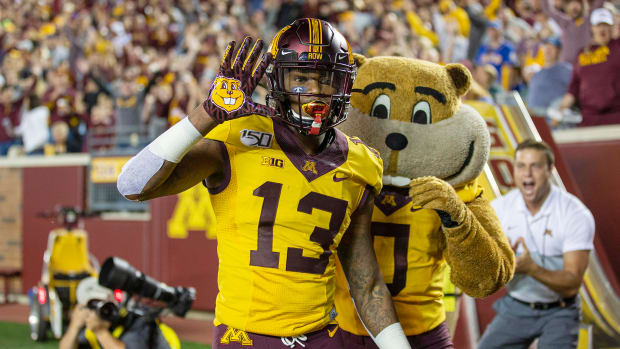
In his sophomore season in 2019, Bateman caught 60 catches for 1,219 yards and 11 touchdowns to move his name onto the NFL radar. He played in five games last season (36/472/2) before deciding to opt-out after a game was canceled due to Covid. Bateman finished his college career with six impact games (7/175/2, 7/105/1, 6/177/2, 7/203/1, 6/147/1, and 10/139/1) over 31 starts.
Bateman has a good feel for setting up defenders off the line and the skill set to make plays at all three levels of the defense. His hands are assets while coming in at 6’0” and 190 lbs. He lacks the quickness to create space in a deep route tree, and elite cornerbacks can shut him down.
There is a good player in Bateman's package while improving in a couple of crucial areas. I expect him to get drafted higher than most sites have him ranked.
7. Kadarius Toney, Florida
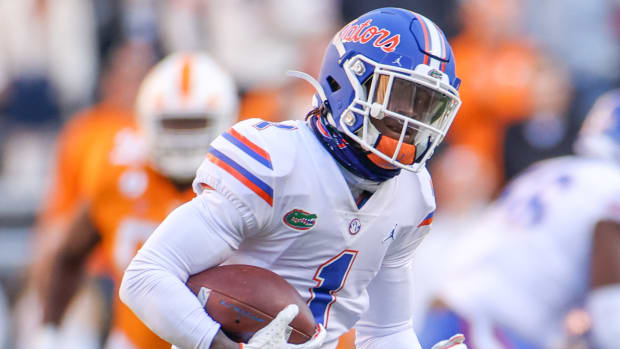
After working in a split role between running back and wide receiver over his first three seasons (1,025 combined yards with three touchdowns and 50 catches), Toney had a starting opportunity for Florida in 2020. He finished 70 catches for 984 yards and 10 touchdowns with some damage on the ground (19/161/1). His star rose over his final three games (8/108/1, 9/182/1, and 8/153/1) in his college career.
He came to the Gators as a quarterback while transitioning to wide receiver. Toney missed time in two seasons with injuries, which restricted his development. His route running has a running back feel where he relies on head and shoulder fakes to create space and separation. His play grades well in the open field thanks to his wiggle in space.
To make an impact in the NFL, Toney needs to improve his route running. His lower half paves his way to success, and he does catch the ball well when given a chance. Early in his career, Toney may land a role as a punt returner.
8. Nico Collins, Michigan
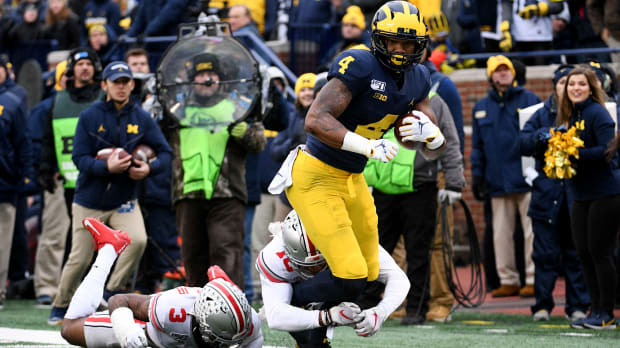
Over his final two seasons at Michigan, he worked as a deep threat leading to 75 catches for 1,361 yards and 13 touchdowns. He opted out of 2020. His best output came last year against Indiana (6/165/3) while failing to gain over 100 yards in any other game in his career.
He brings size (6’4” and 215 lbs.) and speed (4.42 forty) to the wide receiver position, but Collins offers minimal value over the short areas of the field. His hands play well while lacking depth in his route running. He’ll draw attention in the deep passing game while needing a long passing window to have a productive day in catches. Collins doesn’t fire off the line of scrimmage vs. the press with too many tells when declaring his direction out of his breaks.
Collins looks to be a developmental player with a minimal chance of starting early in his career. An NFL team looking to spread the field with four wide receivers will be attracted to him after the first two rounds of the draft.
More NFL Draft Coverage: